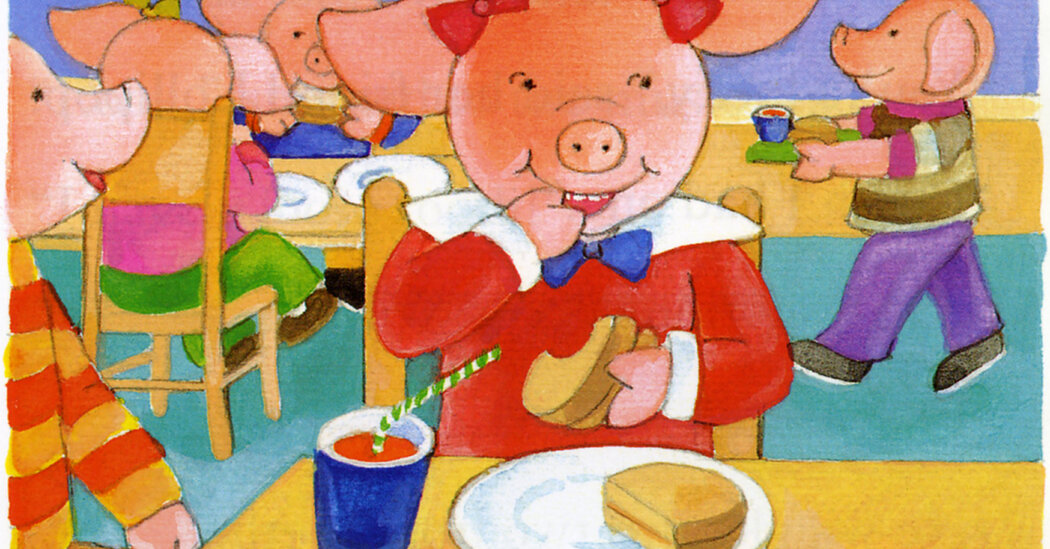
Jean Van Leeuwen, 87, Dies; Wrote ‘Oliver Pig’ Series of Children’s Books
She wrote for many ages, from picture books to young adult fiction. Her children led her to create a series of books about two pigs named Oliver and Amanda.
Jean Van Leeuwen, an award-winning children’s book author whose popular characters included the wholesome siblings Oliver and Amanda Pig and an adventurous, cocksure mouse named Marvin the Magnificent, died on March 3 at her home in Chappaqua, N.Y. She was 87.
Elizabeth Gavril, her daughter, said the cause was cancer.
Ms. Van Leeuwen (pronounced LOO-en) wrote almost 60 books for readers across age groups, from picture books to young adult fiction. She was well known for her 20 slim volumes about an anthropomorphic pig family — for emergent readers, ages 4to 6 — that began in 1979 with “Tales of Oliver Pig” (illustrated by Arnold Lobel). The series continued for 29 years, ending with “Amanda Pig and the Wiggly Tooth” (illustrated by Ann Schweninger), in which one of Amanda’s teeth becomes loose after she takes a big bite of a peanut butter sandwich.
Ms. Van Leeuwen had written a few books before her children were born — David Gavril, in 1972, and Elizabeth Gavril, a year later. But observing their everyday behavior inspired her to tap out a series of short stories on her portable typewriter about a little boy and girl. She turned them into animal children and then, specifically, into pigs. “Tales of Oliver Pig” was followed by “More Tales of Oliver Pig” in 1981 and “Amanda Pig and Her Big Brother” a year later.
The novelist Mary Gordon, writing about “More Tales of Amanda Pig” in The New York Times Book Review in 1985, said that “one of the great values” of the Oliver and Amanda books “is their ability to dramatize the ridiculous and trivial and sickeningly frequent fights that siblings engage in every day of their lives, and yet suggest the siblings’ essential fondness for each other, their dependency, their mutual good will.”
David Gavril said in an interview that his mother was “very observant” and had most likely been taking notes “very discreetly” about his and his sister’s lives. In a separate interview, Elizabeth Gavril said: “I don’t recall being surprised that the characters were pigs. It’s a universal thing in children’s publishing that animals can have human characteristics.”
Ms. Schweninger, whose watercolors illustrated 18 of the 20 Oliver and Amanda books, said that over time “the stories became a little broader than the early ones when her children were at home.”
“They were growing up, their activity levels increased and they were going to school,” she added.
Ms. Van Leeuwen won the American Library Association’s Theodor Seuss Geisel Award in 2006 for “Amanda Pig and the Really Hot Day.” The award is given for contributions to beginner reader books.
She also received a Washington Irving Children’s Book Choice Award from the Westchester Library System in 1996 for “Emma Bean” (illustrated by Juan Wijngaard), about a homemade stuffed rabbit and the girl who adores her.
Reviewing two children’s books in The Times Book Review in 1987, Ms. Van Leeuwen described how to reach young readers: “The challenge of writing an easy-to-read book, with its strict limits of length and vocabulary, is to tell a story that is simple but not ordinary.”
Jean Van Leeuwen was born on Dec. 26, 1937, in Glen Ridge, N.J., and grew up in nearby Rutherford. Her father, Cornelius, was a minister, and her mother, Dorothy (Charlton) Van Leeuwen, was a teacher. Jean voraciously read the newspapers and magazines that her parents brought home.
After earning a bachelor’s degree in 1959 from the Syracuse University School of Journalism (now the Newhouse School of Public Communications), she wrote for TV Guide and became a children’s book editor in 1963. She worked for Random House, Viking Press and Dial Books for Young Readers for 10 years until her daughter was born.
Phyllis Fogelman, a former president of Dial Books for Young Readers — who was Ms. Van Leeuwen’s boss before becoming her editor, a relationship that continued for decades — told The Times in 1995 that Ms. Van Leeuwen’s “pitch is always perfect” and that “Jean has a deft touch with characterizations.”
The Times reported that the 28 books Ms. Van Leeuwen had written by that year had sold two million copies.
Her books also include “The Great Cheese Conspiracy” (1969), in which she introduced beginner readers to Marvin the Magnificent, a tough braggart of a mouse who hangs out with his rodent pals, Fats and Raymond. It was adapted into an animated film in 1986, in the Czech language, by the director Vaclav Bedrich.
In “The Great Christmas Kidnapping Caper” (1975), the gang, which lives in a dollhouse in a Macy’s toy department, sets out to rescue the man playing Santa Claus. And in “The Great Rescue Operation” (1982), Fats disappears when his napping place, a doll carriage, is sold while he is asleep in it.
Ms. Van Leeuwen also wrote “Benjy and the Power of Zingies” (1982), about a third grader who believes that overindulging in a cereal promoted by star athletes will make him strong. Her young adult novel “Seems Like This Road Goes On Forever” (1979) is about a minister’s teenage daughter who recalls her self-destructive behavior from her hospital bed. And, in “Across the Wide Dark Sea: The Mayflower Journey” (1995), she wrote a historical fiction picture book narrated by a boy who describes the Pilgrims’ passage from England to Plymouth Harbor in 1620.
In addition to her daughter and her son — who illustrated his mother’s book “Chicken Soup” (2009) — Ms. Van Leeuwen is survived by her husband, Bruce Gavril; two grandchildren; her sister, Barbara Kossuth; and her brother, John Van Leeuwen.
For many years, Ms. Van Leeuwen volunteered at the elementary school in Chappaqua that her children had attended, helping first graders with their writing.
“They didn’t know her as an author; they knew her as Mrs. Gavril,” her daughter said. “At the end of the year, they were told that Jean Van Leeuwen, whose books they’d been reading, would be speaking to the class.
“Then came the surprise reveal — that it was Mrs. Gavril.”










